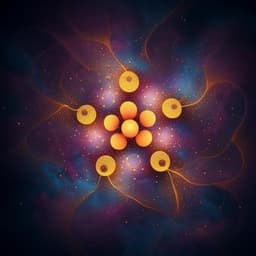
Physics
Macroscopic manifestation of domain-wall magnetism and magnetoelectric effect in a Néel-type skyrmion host
K. Geirhos, B. Gross, et al.
This research unveils an unprecedented magnetic state in GaV₄Se₈, emerging solely in specimens with mesoscale polar domains. The phenomenon is marked by a distinct anomaly in magnetic susceptibility, leading to exciting implications for novel magnetism, spearheaded by a talented team of researchers including Korbinian Geirhos and Boris Gross.
~3 min • Beginner • English
Introduction
The study investigates whether structural domain walls (DWs) in polar, non-centrosymmetric magnets can host distinct magnetic states that manifest in bulk measurements. Prior work showed that in lacunar spinels (e.g., GaV₄S₈, GaV₄Se₈, GaMo₄S₈) with a Jahn–Teller-driven polar rhombohedral phase, a Néel-type skyrmion lattice (SkL) and cycloidal magnetic textures occur. The polar symmetry fixes magnetic anisotropy axes and Dzyaloshinskii–Moriya (DM) vectors, making magnetic states domain-dependent. The authors hypothesize that at polar DWs, where adjacent domains have different anisotropy axes and DM vectors, mismatched cycloids can generate confined magnetic textures with distinct stability ranges and magnetoelectric responses. They aim to demonstrate a macroscopic signature of such DW-confined magnetism in GaV₄Se₈ and to map its field–angle dependence relative to known cycloidal, SkL, and ferromagnetic (FM) phases.
Literature Review
- Reduced dimensionality and interfaces can host emergent quantum phases (e.g., topological surface states, 2D electron gases, superconductivity, quantum Hall edge states).
- Ferroelectric DWs exhibit unconventional electrical functionalities (conductivity, rectification, enhanced switching) in materials like YMnO₃, ErMnO₃, BiFeO₃, LiNbO₃, PbₓSr₁₋ₓTiO₃.
- Structural changes at DWs can modify magnetic interactions and spin order in oxide heterostructures and thin films.
- Geometric confinement stabilizes skyrmions and can produce exotic magnetic edge states (e.g., chiral bobbers).
- Lacunar spinels (AB₂X₄) show rich correlated-electron phenomena and, crucially, host Néel-type SkL states; GaV₄Se₈ has a polar rhombohedral phase (R3m) essential for SkL formation.
- Oblique-field effects on SkL/cycloidal stability, including predicted re-entrant cycloidal phases, have been theorized but not comprehensively observed in GaV₄Se₈ prior to this work.
Methodology
- Sample synthesis: Single crystals of GaV₄Se₈ (1–30 mg) grown by chemical vapor transport with iodine. Crystal orientations determined via X-ray Laue and neutron diffraction.
- Scanning probe microscopy (SPM): Conducted in a low-temperature UHV AFM using nc-AFM, scanning dissipation microscopy, and frequency-modulated Kelvin-probe force microscopy (FM-KPFM). Probes: Nanosensor SSS-QMFMR (k=3.4 N/m, f₀≈77.7 kHz) for magnetic measurements and PtSi-FM (k=2.5 N/m, f₀≈73.3 kHz) for others. Operating at Δf=100 Hz, oscillation amplitude ~10 nm; contact potential differences compensated via Kelvin control. For MFM, tips magnetized along z; two-pass imaging with ~30 nm lift height. FM-KPFM used 5 V modulation at 4.1 kHz; sample backside biased at −145 V; sideband detected and nulled to extract local contact potential. Data analyzed with Gwyddion.
- Magnetization and ac susceptibility: Measured after zero-field cooling using a Quantum Design MPMS. For ac susceptibility with electric-field poling, a custom probe applied poling fields during cooling.
- Magneto-current (pyro- and magneto-current): Contacts on parallel (111) faces (silver paint). Measurements in an Oxford He-flow cryostat with a rotatable platform (stepper motor) enabling controlled angle between magnetic field and contacts. Low-noise coaxial wiring. Current recorded with Keysight B2987A during magnetic field sweeps (0.5–1 T/min). Pyrocurrent recorded during temperature sweeps (3–50 K at ~6 K/min).
- Torque magnetometry (dynamic cantilever magnetometry, DCM): A ~100 µm GaV₄Se₈ crystal mounted on a commercial cantilever (Arrow-TL1). Self-oscillation at resonance; dissipation change ΔΓ measured vs field H (up to 4.5 T) and angle within the cantilever oscillation plane. Vibration-isolated closed-cycle cryostat (<10 mbar) with 4–300 K control; optical fiber interferometer readout (1550 nm, ~100 nW).
- Small-angle neutron scattering (SANS): 11.6 mg GaV₄Se₈ single crystal. Primary patterns on SANS-I (SINQ, PSI) with λ=6 Å, 6 m collimation and detector distances; field rotated in (110) plane. Supplemental field-dependent data on D11/D33 (ILL) with λ=5 Å, 5 m geometry. Rocking scans used to integrate magnetic Bragg peaks through the Ewald sphere; paramagnetic (20 K) background subtracted.
- Domain characterization and control: Polar domains imaged via SPM and MFM; lamellar neutral (100)-type DWs identified. Electric poling along [111] used to prepare nearly single-domain (P₁) or multi-domain states; pyrocurrent used to quantify polarization and domain populations. Field-angle φ defined within (110) plane relative to [111].
- Phase diagram construction: Combined anomalies from magneto-current, torque, magnetization/susceptibility, and SANS to assign cycloidal, SkL, FM phase boundaries for specific domain types (P₁, P₂) and assemble domain-resolved and effective mono-/multi-domain phase diagrams.
Key Findings
- Discovery of a sharp, additional magnetic transition that appears only in polar multi-domain GaV₄Se₈ crystals and is absent in electrically poled mono-domain samples.
- Manifestations: sharp peak in ac susceptibility (~100 mT) for H∥[001] (≈54° to all domain axes), clear steps in magneto-current, and a weak but discernible anomaly in torque dissipation ΔΓ at similar fields/angles; no corresponding SANS anomaly observed (likely due to signal/noise and field resolution).
- Electric poling suppresses this anomaly in both samples #1 and #2 once mono-domain states (P₁ or P₂) are realized, confirming the multi-domain (DW) origin.
- Interpretation: The anomaly is attributed to DW-confined magnetic textures that transform to the ferromagnetic state at lower fields than the cycloidal textures inside domains, due to altered DM vectors and anisotropy across DWs.
- Quantitative estimates: typical DW spacing ~100–500 nm; cycloidal pitch ~20 nm; magnetization jump associated with the DW transition corresponds to ~1–2% volume fraction, implying an effective DW-confined magnetic thickness of ~3–6 nm.
- The cycloidal mono-domain state inside domains is already selected by a transverse field component H⊥ at H₁≈40 mT (q-vector reorientation), preceding the DW transition.
- Angular/phase-diagram results:
- SANS at 12 K and μ₀H=220 mT with field rotated in the (110) plane shows sequence SkL → cycloidal → FM as φ increases from 0° ([111]) toward ⟂ to [111].
- Re-entrant cycloidal phase observed for oblique fields φ≈21–29°: cycloidal → SkL → cycloidal → FM, confirming theoretical predictions.
- Domain-resolved phase boundaries (1a,1b for P₁; 2a,2b for P₂) established from magneto-current and torque; additional DW-only boundary (1*,2*) collapses onto a single line when referenced to each domain’s polar axis, indicating specific DW types (P₁–P₃/P₂–P₄ or P₁–P₄/P₂–P₃) host the confined states for H∥[001].
- Magnetoelectric response: The DW-confined transition produces clear magneto-current anomalies, evidencing a strong contribution of DW states to the magnetoelectric effect.
- Domain patterns: Lamellar, electrically/mechanically compatible domains with widths ~100–500 nm; only 109° DWs present (no 180° DWs) due to non-centrosymmetric parent cubic phase; electric poling along [111] selects P₁ mono-domain vs the triad P₂–P₄, with polarization ratio consistent with geometry (≈3:1).
Discussion
The findings provide macroscopic evidence that structural polar DWs in GaV₄Se₈ host distinct magnetic textures not present within domains. The sharp, poling-dependent anomaly confined to multi-domain samples indicates a phase transition of DW-localized states. The altered orientation of DM vectors and anisotropy across DWs frustrates the continuity of cycloidal modulations across adjacent domains, stabilizing edge-like spin textures at DWs with a reduced critical field for transition to FM (critical field scaling ∝ D²/J suggests local DM weakening at DWs reduces stability of modulated phases). The coalescence of the 1* and 2* boundaries when referenced to each domain’s axis identifies which DW orientations support the confined states for given field directions, consistent with the mismatch of cycloidal spin rotation planes across specific DWs. While SANS does not resolve the DW transition (small volume fraction and limited resolution), bulk magnetoelectric and torque signatures clearly reveal it. The broader phase mapping, including re-entrant cycloidal behavior for oblique fields, refines the established phase diagram of GaV₄Se₈ and demonstrates the profound role of structural domain architecture in determining magnetic and magnetoelectric responses.
Conclusion
This work demonstrates a macroscopic manifestation of domain-wall magnetism and magnetoelectricity in the Néel-type skyrmion host GaV₄Se₈. A sharp, DW-specific magnetic transition appears only in multi-domain samples and is linked to confined spin textures at polar DWs that transition to FM at fields where cycloidal order persists in domains. The transition strongly affects magneto-current and subtly affects torque/susceptibility, indicating a significant DW contribution to the magnetoelectric effect. Quantitative analysis suggests DW-confined magnetic regions only a few nanometers thick (~3–6 nm). The comprehensive field–angle phase diagrams, including observation of a re-entrant cycloidal phase, extend understanding of oblique-field effects in this system. These results point to polar DWs as fertile platforms for emergent magnetism beyond bulk textures. Future work should employ high-resolution, real-space magnetic imaging (e.g., Lorentz TEM, spin-polarized scanning probes, NV magnetometry) to directly resolve DW spin textures, explore tunability via strain/electric fields, and examine generality across other polar magnets and lacunar spinels.
Limitations
- The DW-confined transition is inferred from bulk magnetization, magneto-current, and torque; direct real-space imaging of the DW spin texture was not achieved due to experimental challenges in GaV₄Se₈.
- SANS did not resolve the DW anomaly, likely due to small DW volume fraction and limited field resolution/signal-to-noise.
- Complete electric poling to ideal mono-domain states was not always feasible (particularly for torque measurements), potentially broadening comparisons.
- The precise microscopic structure and energetics of DW-confined textures remain to be determined; estimates of thickness rely on domain spacing and magnetization step assumptions.
Related Publications
Explore these studies to deepen your understanding of the subject.







